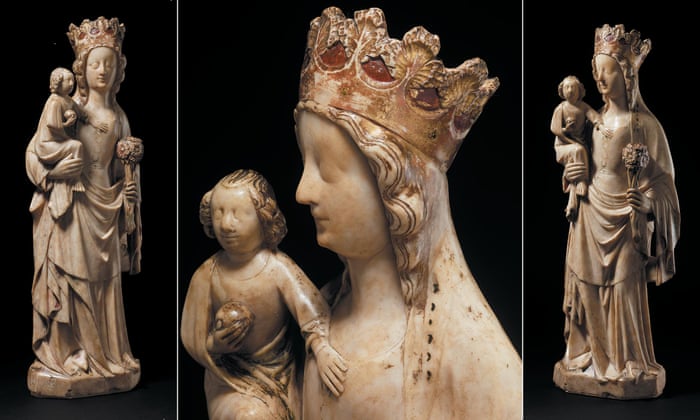I saw on Medievalists.net on Tumblr the following report of the acquisition by the British Museum of an Engliah alabaster statue of circa 1350 of the Virgin and Child and am reproducing it below, with some additional images.

Image:Art Fund
The British Museum has acquired an outstanding fourteenth-century English alabaster figure of the Virgin and Child which is the best-preserved of its kind on display in a UK national collection.
The sculpture probably originates from the Midlands and provides a precious insight into carved alabaster from the period that was otherwise largely destroyed, hidden or sold abroad during the English Reformation. The fourteenth-century artists who worked alabaster of this quality attracted the attention of King Edward III, who ordered a carved alabaster altarpiece from Peter the Maceon of Nottingham in the late 1360s. The altarpiece he commissioned for the chapel of St George at Windsor, along with the totality of comparable pieces in situ, were destroyed, buried or sold abroad during the English Reformation. This statue of the Virgin and Child is a rare survivor that escaped this wave of destruction triggered by Protestantism, having perhaps been exported to the continent at the time of its manufacture, or sold off when imagery of this sort was no longer allowed.
Image:Medievalists.net
The sculpture is in remarkable condition and is extraordinary in having suffered no major breakages. Even rarer is the survival of large portions of the original decoration, including gilding and imitation jewels which decorate the chest of the Virgin. There are traces of original red and green painting and substantial gilding across the sculpture. The figure has a sophisticated sway emphasising the relationship of mother and child. The reverse of the sculpture is uncarved, suggesting that the figure was originally positioned against something within a tabernacle or architectural niche.
The alabaster figure was purchase by the British Museum from the dealer Sam Fogg with support from the Art Fund, National Heritage Memorial Fund and private donations.
The sculpture is now on display in the Sir Paul and Lady Jill Ruddock Gallery of Medieval Europe (G40).

Image: The Guardian
The British Museum website itself reports on the statue at British Museum acquires outstanding alabaster Virgin and Child, together with a set of views of another statue already in the collection featured at British Museum - Image gallery: statue
There are other website articles about the statue from the Guardian at Medieval statue that survived persecution is back on show at British Museum acquires rare alabaster of the Virgin and Child
from the Art Fund and in an article from the Catholic Herald at 'A haunting glimpse of what we lost'
Image: Catholic Herald


No comments:
Post a Comment